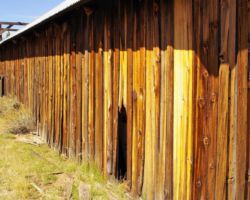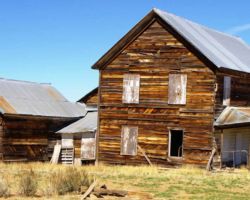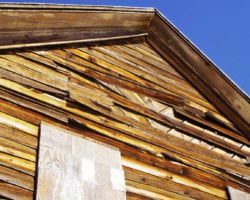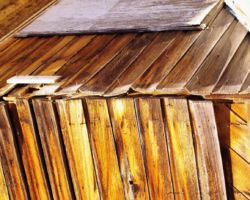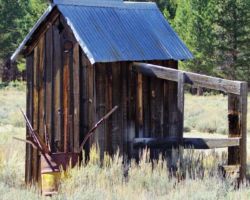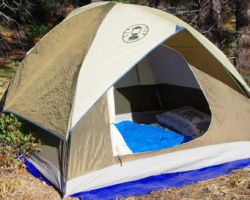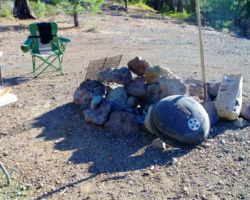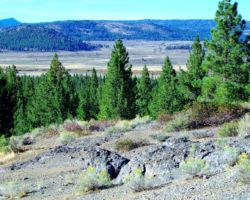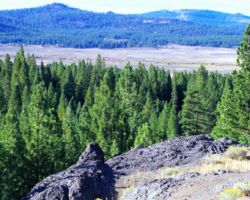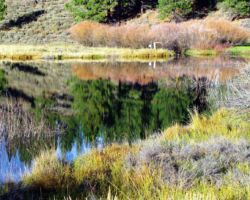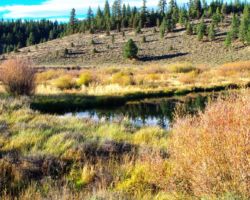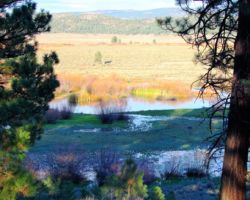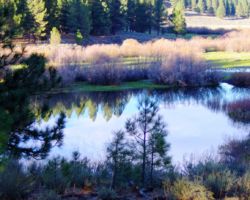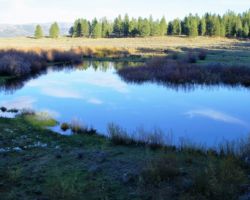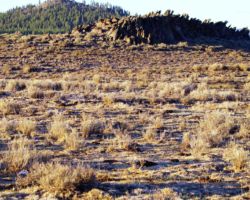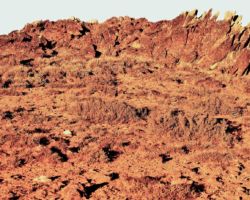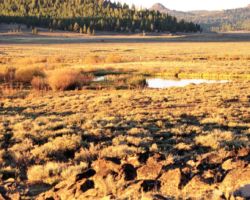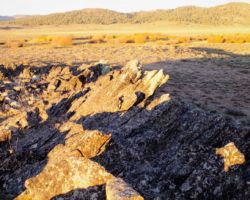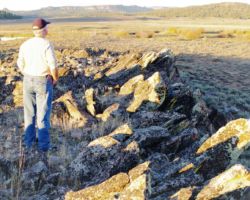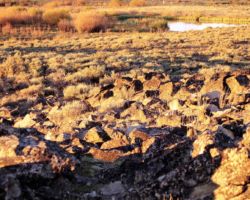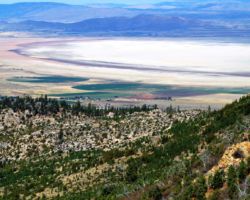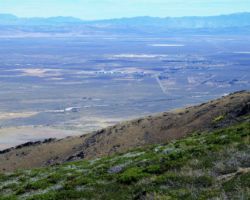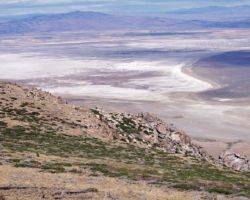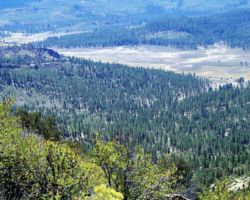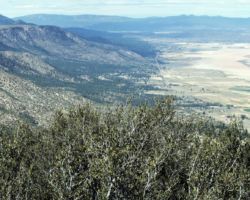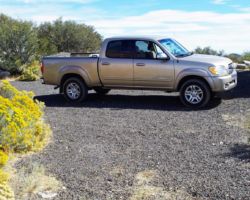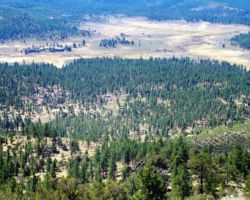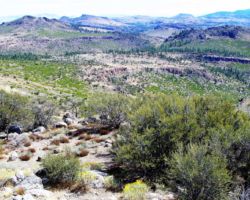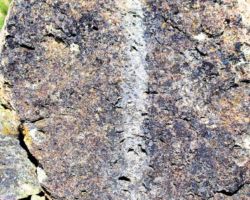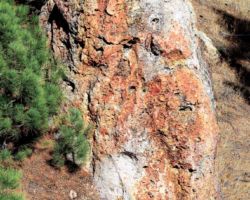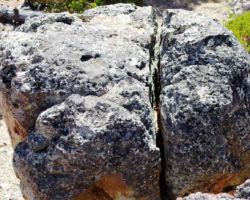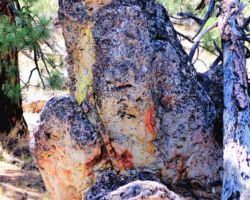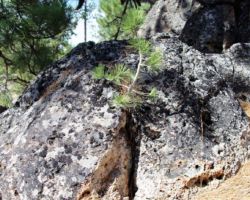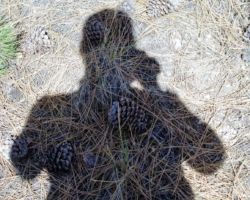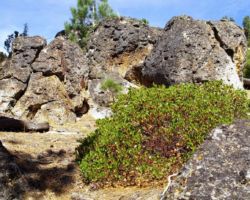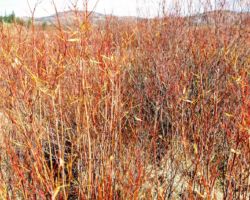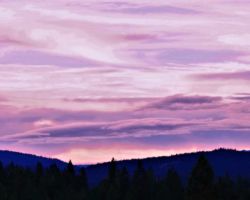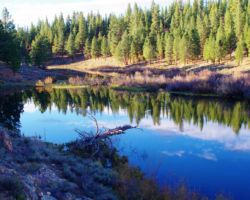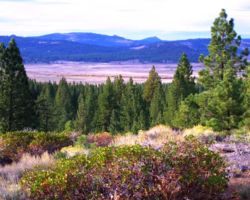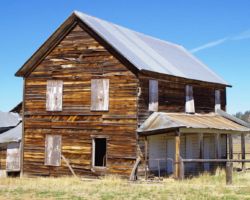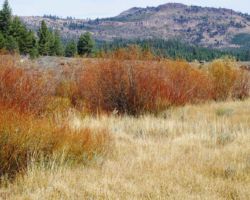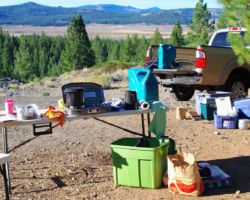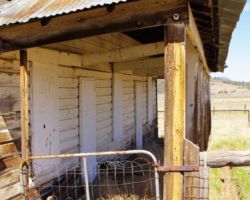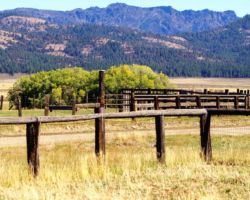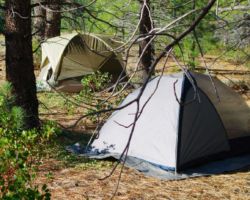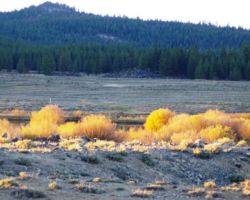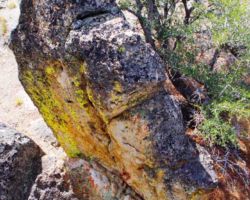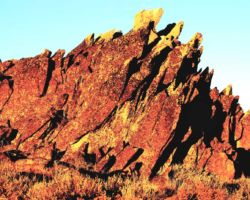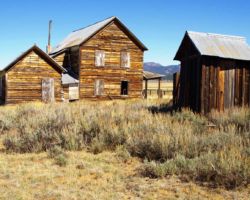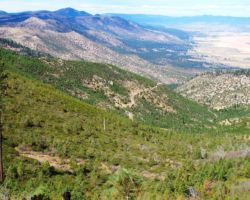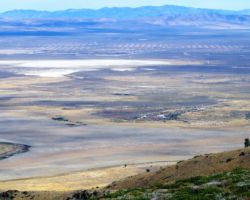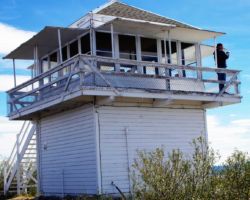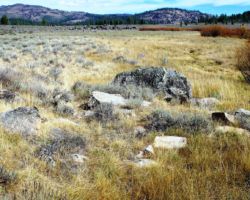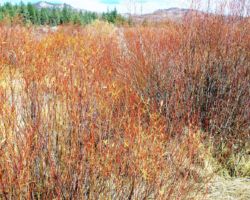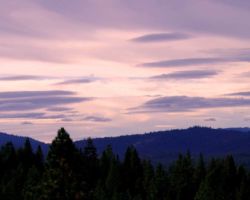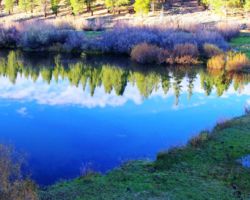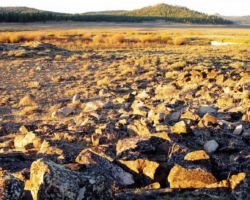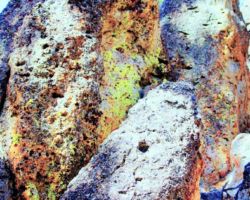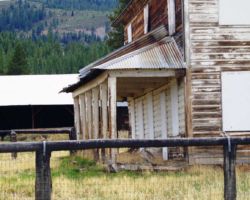
Clover Valley Ranch, Plumas National Forest
Trip Date: September 27, 2013
It is intriguing how things connect sometimes. A funny email sent by a friend has a link, that is followed, that has a link, that is followed, that has an interesting opportunity and a contact. Sometimes we are connected and certainly, sometimes we are not – or at least feel like we are more alone and flying solo than we are. Often the opportunities for connectivity are all around; it is just up to us, or them, to make it.
The choice was made to follow the links and act on the impulse to send an email, from my desk in front of a computer inside a tiny cubicle in a giant office building in Sacramento, to the stranger listed as a contact in faraway Bozeman, Montana. Thus, this journey began. The link that Tom sent me about a travel/adventure blog, had a link to a story in Adventure Journal on cabins that could be rented, which had a story on a cabin at Summit Springs Ranch, in Idaho. The property the cabin sits on is one of several large ranches that belong to Beartooth Capital.
 Fortunately, the Beartooth Capital stranger in Bozeman was incredibly responsive and friendly and through his effort, we learned about another property they own and are working to restore in Plumas County called Clover Valley Ranch. With Mike’s help, I was referred to their California contact – Ryan, and with Ryan’s assistance, we were able to access this property.
Fortunately, the Beartooth Capital stranger in Bozeman was incredibly responsive and friendly and through his effort, we learned about another property they own and are working to restore in Plumas County called Clover Valley Ranch. With Mike’s help, I was referred to their California contact – Ryan, and with Ryan’s assistance, we were able to access this property.
Clover Valley Ranch sits in the middle of over 1 million acres of Plumas National Forest which extends from the foothills around Oroville to the Sierra Nevada high country near Susanville. Clover Valley sits at about 5500’ elevation and remains virtually unchanged since it was first settled in the early 1800’s. It was a Swiss dairy ranch and a stage stop between Beckwourth, Vinton, Chilcoot, and Loyalton and the Sierra Valley communities and Genesee, Taylorsville, Greenville and the Indian Valley settlements Northwest towards Lake Almanor.
The valley has two creeks, Dixie and Red Clover running through it, as well as several other smaller tributaries. The amount of water present is instantly apparent with the great growth of grasses, sage, willow, and a rich diversity of riparian vegetation that is alive with birds. It is an area rich in history and beauty that quickly transports you back to the California of 150 years ago.
 The first thing we saw in the valley after a quick and beautiful 2.5 hour drive from Sacramento, were two cow-pokes riding hard like a rodeo barrel race to corner and rope a massive bull. I was not ready for such action as I wobbled out of the truck and waited to get some feeling back in my legs after sitting so long. I wish I had my camera ready, but these guys were hard at work and not wasting any time with us flatlanders poking around the old farm house and barn. With a rope around their quarry, they were back down the road bringing him to where he was supposed to be. This was real cowboy’n right out of the old West – it was quite a beginning to the trip.
The first thing we saw in the valley after a quick and beautiful 2.5 hour drive from Sacramento, were two cow-pokes riding hard like a rodeo barrel race to corner and rope a massive bull. I was not ready for such action as I wobbled out of the truck and waited to get some feeling back in my legs after sitting so long. I wish I had my camera ready, but these guys were hard at work and not wasting any time with us flatlanders poking around the old farm house and barn. With a rope around their quarry, they were back down the road bringing him to where he was supposed to be. This was real cowboy’n right out of the old West – it was quite a beginning to the trip.
Not wanting to be next varmint with a rope around my neck, we did not lounge at the ranch house for long. Ryan had sent a map with the location of several camp sites in the woods South of the farmhouse, but I had been intrigued by the idea of camping out in the meadow or at least near the creeks and restored wetlands. So Tom and I headed North to the far side of the meadow to see if we could find a track down near the creek that was not yet visible from the roads.
 Driving out into the middle of the valley really gave a sense of how immense it is – open and vast – a great expanse of meadow, wetlands, and riparian habitat. Driving across the meadow, we quickly lost focus with the presence of so many roads. I don’t regret not sticking with the original plan, but we never did get down along the North side of the meadow to see if there were potential camp sites, but instead took a long loop to the Northwest into some wooded hills with much surface water for late September. Eventually the road swung back across the meadow – far to the West of the ranch house.
Driving out into the middle of the valley really gave a sense of how immense it is – open and vast – a great expanse of meadow, wetlands, and riparian habitat. Driving across the meadow, we quickly lost focus with the presence of so many roads. I don’t regret not sticking with the original plan, but we never did get down along the North side of the meadow to see if there were potential camp sites, but instead took a long loop to the Northwest into some wooded hills with much surface water for late September. Eventually the road swung back across the meadow – far to the West of the ranch house.
This was still by no means the end of the valley, but possibly the mid-point; the meadow stretching out in both directions as far as the eye could see. Heading back East towards the farmhouse, we stopped several times to walk gated/fenced roads that led back out to wetlands in the middle of the meadow. The meandering streams formed many ponds and small oxbow lakes that supported an immense amount of plant life. I can only assume the cacophony of bird calls was proportionate to the delight and joy that came with living in such a bucolic setting.
Back near the ranch, we followed the map and directions to the camp sites and checked each of them out before settling into the one farthest from the road, highest up onto the mountain and offering the best view. The view was considerable; facing North, we could see a few miles of the valley below with the dark squiggly line of the creek and the vegetation along the creeks. Through the binoculars, we could see the black specs of cows and an occasional hawk, woodpecker, or Raven. We could make out short stretches of roads along the edges of the meadow and over the hills beyond.
Our camp site was on the edge of a large ravine to the West, and was very rocky and open to the North so we could see well off in those two directions. We were up against the forest to the East which offered great spots for the tents. The main area of the site was a very large gravel patch which made for almost no dust or loose dirt; other than when you are camping in the forest where the tree leaves and needles haven’t been trampled by heavy use, it is rare to have a site with so little dirt and dust. There was a large fire ring but nothing else. With a little amount of effort, the fire ring was vastly improved with an excellent bench for the grill and a large back wall to act as a wind break and upper shelf for tools, mitt, and perhaps a beverage within reach without having to bend over – not a trifling matter.
 With having secured a great spot and explored a bit, we unloaded and set up in short order. It was a great feeling to be with Tom and to think back on all the connectivity from the original email with the link to Beartooth Capital, corresponding so much with those folks, and now actually being here. The weather was great, it smelled great, and we felt great. Soon our attention lasered in on eating and celebrating the day.
With having secured a great spot and explored a bit, we unloaded and set up in short order. It was a great feeling to be with Tom and to think back on all the connectivity from the original email with the link to Beartooth Capital, corresponding so much with those folks, and now actually being here. The weather was great, it smelled great, and we felt great. Soon our attention lasered in on eating and celebrating the day.
We had previously talked about having a fishy night and then a meat night. Since seafood spoils so quickly, we usually have it on the first night. I had some frozen shrimps and quickly got the butter melted in the cast iron skillet with some white wine, a little pepper and some seasoning that had a little kick that Tom brought. The warm afternoon and the open flame of the fire forced me to take my shirt off and sauté the shrimps in the heat of the moment. The first wave of shrimps went down quite well and the second round simply disappeared. They were an excellent appetizer.
 Tom had an excellent salmon steak and Kristen had secured an excellent whole trout for me. Tom BBQ’d both to perfection along with two ears of corn and two reheated yams I had baked at home. When a whole fish is cooked just right, the skin is blackened and just falls off the meat; then the meat peels away from the bone very easily and you quickly and easily eat big chunks of beautiful, juicy skinless/boneless fish meat. My god was that good eatin – and healthy as hell too – nothing but fish and veggie’s.
Tom had an excellent salmon steak and Kristen had secured an excellent whole trout for me. Tom BBQ’d both to perfection along with two ears of corn and two reheated yams I had baked at home. When a whole fish is cooked just right, the skin is blackened and just falls off the meat; then the meat peels away from the bone very easily and you quickly and easily eat big chunks of beautiful, juicy skinless/boneless fish meat. My god was that good eatin – and healthy as hell too – nothing but fish and veggie’s.
Tom is famous (and yes infamous) for his Manhattan’s. I believe he started to bring them on our trips regularly after he heard a story of my uncle Bob. He was the oldest in my mom’s family of nine; an enormous man, maybe six foot four and thick and wide as a refrigerator. He was a San Francisco beat cop back in the day when cops actually walked around neighborhoods and an offensive lineman for Army and SF City College before that. One of my mom’s favorite stories was just before half time of a football game, Bob was called for a penalty and it hurt the drive the team was putting together. My grandma, their mom, ran out on the field as the teams’ were running off to their locker rooms and she gave hell to the referee. Bob, about a foot and a half taller than her, just about had to tuck her under his arm like a loaf of sourdough and haul her back to the stands, but she was going to stand up for her son when she thought he had been unfairly and inaccurately accused of foul play. This incident made Herb Caen; a famous San Francisco columnist who wrote a daily column about the City for the Chronicle for 60 years.
 Bob and his younger brother, Skinny (Erwin if you must), my mom’s twin and an SF County Sheriff, would take their gun belts off when they arrived at their parents’ house and put them up on the shelf of the Teak paneling that surrounded the entire dining room of their house on 23rd between Ulloa and Vicente.
Bob and his younger brother, Skinny (Erwin if you must), my mom’s twin and an SF County Sheriff, would take their gun belts off when they arrived at their parents’ house and put them up on the shelf of the Teak paneling that surrounded the entire dining room of their house on 23rd between Ulloa and Vicente.
This always impressed me being a small boy; one that they could reach the top of the paneling with ease (not even reaching up really), and two that there were two loaded guns up there. Fortunately for all they never fell down and I was a perfect angel of a little boy and never even dreamed of getting one down and shooting the hell out of all that crossed me!
Anyway, it was at my uncle Red’s (Bernard for the family tree types) wedding, I believe the story goes, that Mr. Elyssanborough had made a bucket of Manhattan’s a month prior to the wedding to let them marinate appropriately. Bob apparently loved his brother very much as he made many toasts until he literally fell on his face, not an outstretched arm or conscious thought in his brain when he hit terra firma with his nose. He was so massive and so heavy, a dozen or so of the fellas had to use a door they took off the hinges to carry him out of the hall and dump (I mean gently place) him somewhere.
 Thus, the Manhattan’s gained traction with the boys and they have been a staple ever since. This particular trip, however, was not significantly long enough beyond a rather offensive and debilitating experience Tom had, and therefore, the container of Manhattan’s was a rather small one. This was fine with me because while I definitely wanted my buzz, I most certainly did not want to vibrate my tiny brain cells too violently as I too had an impressive yet undistinguished episode the prior weekend. And, of course, having been granted permission to access this spectacular piece of private paradise, I didn’t want to make a scene.
Thus, the Manhattan’s gained traction with the boys and they have been a staple ever since. This particular trip, however, was not significantly long enough beyond a rather offensive and debilitating experience Tom had, and therefore, the container of Manhattan’s was a rather small one. This was fine with me because while I definitely wanted my buzz, I most certainly did not want to vibrate my tiny brain cells too violently as I too had an impressive yet undistinguished episode the prior weekend. And, of course, having been granted permission to access this spectacular piece of private paradise, I didn’t want to make a scene.
 The evening was spectacularly clear, cold, but calm, and with a great fire we were warm and content. I rarely can avoid staring in a trance-like state at the flames, to the ignorance of all around me, but this night was different. I couldn’t take my eyes of the twinkling stars and the glowing ribbon of the Milky Way. Because I was transfixed on the sky, I saw several shooting/falling stars, one in particular slicing right through the “spoon” part of the Big Dipper. It was not late, but it had been a hugely wonderful day, and me eyes were heavy and the day long, so I retired to my comfy tent and three sleeping bags. I needed them all along with my wool socks, long sleeves, and my cap. Crystal clear often equals cold and this night was proving that theorem thoroughly.
The evening was spectacularly clear, cold, but calm, and with a great fire we were warm and content. I rarely can avoid staring in a trance-like state at the flames, to the ignorance of all around me, but this night was different. I couldn’t take my eyes of the twinkling stars and the glowing ribbon of the Milky Way. Because I was transfixed on the sky, I saw several shooting/falling stars, one in particular slicing right through the “spoon” part of the Big Dipper. It was not late, but it had been a hugely wonderful day, and me eyes were heavy and the day long, so I retired to my comfy tent and three sleeping bags. I needed them all along with my wool socks, long sleeves, and my cap. Crystal clear often equals cold and this night was proving that theorem thoroughly.
The morning light was very fresh and young when we wiggled from our nests. Tom already had a fire going and the pot of my homegrown organic, homemade brew/sauce/ Ratatouille was still resting comfortably on the stove top. I had pulled it out in case we needed a late night snack, but we both have regular bouts of heartburn/ indigestion/acid reflex so we thought the better of stuffing in a late night load of spicy, tomato-based brew just before we got horizontal. Believe me, there wasn’t enough Tums in all the land to calm that burn. An excellent decision was that.
 So what better way to start off the day? Up went the flame and soon the brew was piping hot. I have to say, I am not a skilled cook, but I can mix stuff together, a good combination in good quantities and make very good brews – call them what you want, but I love random mixes and combinations of flavors, textures, etc. I do not like hot/spicy foods and they tear me up when I try to eat them, but I have been making some dishes with just a tiny amount of kick lately. Lots of our veggie dishes from the garden have had a tiny bit of heat – just the right amount for me which is more than usual, but certainly not much for most people – very good in any case.
So what better way to start off the day? Up went the flame and soon the brew was piping hot. I have to say, I am not a skilled cook, but I can mix stuff together, a good combination in good quantities and make very good brews – call them what you want, but I love random mixes and combinations of flavors, textures, etc. I do not like hot/spicy foods and they tear me up when I try to eat them, but I have been making some dishes with just a tiny amount of kick lately. Lots of our veggie dishes from the garden have had a tiny bit of heat – just the right amount for me which is more than usual, but certainly not much for most people – very good in any case.
I very rarely eat breakfast either. I typically have coffee and then a hardboiled egg, yogurt, maybe toast or a string cheese around 11:00 or so and that is about it. When camping though, most of the norms go out the window, and this was a perfect example. I was hungry – my stomach wanted food, and this pasta was outstanding. Just enough spice to make you want more and eat fast so you couldn’t really feel the heat, you just ate more to control the temperature. Tom’s coffee was excellent and it helped regulate the temperature inside my mouth as well.
Full of pasta and coffee, it was time to grab a shovel and the important papers and take a hike. Up over the slight rise to the East of us, on the forested side of our camp, there was excellent digging in the Piney woods. The experience went masterfully and my gaze soon fell up the hill to some cool rock formations.
 The ground was damp from the overnight moisture, and the brush is scattered in this part of the country – not enough rain to have heavy brush or dense forest, so the walking was good and easy. These rocks were all volcanic in origin, and black as could be – very rough textured and very mangled and angled and tangled. They were beautiful shapes – like the back of a dinosaur or the sharp spiny ridge of the Grand Tetons. They were running in the same direction – parallel to each other – like mini mountain ridges.
The ground was damp from the overnight moisture, and the brush is scattered in this part of the country – not enough rain to have heavy brush or dense forest, so the walking was good and easy. These rocks were all volcanic in origin, and black as could be – very rough textured and very mangled and angled and tangled. They were beautiful shapes – like the back of a dinosaur or the sharp spiny ridge of the Grand Tetons. They were running in the same direction – parallel to each other – like mini mountain ridges.
These were very cool, but I was hunting for the real porous types of rocks, with all the gas bubble holes, not these super dense, solid stones. But it made for a beautiful contrast with the black boulders and ridges against the green of the Pine needles and the gray green brush.
Once back to camp, the sun had finally reached us. I always prefer having an East-facing camp site just to get the early sun. And, for the most part, I am happy to get out of the afternoon sun. This spot was awesome, but had the forest to the East, so the sun was late getting to us on this morn. No matter though, we had a great morning fire, coffee and the pasta, so all was good. And now, we had the sun warming us as well. This just served as even more energy to propel us out of our camp and into the wide open new country.
We decided to drive a bit and see what we could see. By now, I realized I had been in this country before – with my wife several years back looking at 40 acres that was for sale a few miles further North. That property was actually very similar to where we were – meadow, lots of water, and beautiful rock outcroppings covered in moss and lichens.
 As we headed north across the Clover Valley, we decided to check out a fire lookout – usually a great idea for views, to get your bearings and to see off into distant places we may have been at one time or another – connect the dots as we always say. We decided to check out Dixie Mountain Lookout about 10 miles East of us. The road we needed was opposite the right turn we took yesterday when we explored around the ranch property looking for a camp site.
As we headed north across the Clover Valley, we decided to check out a fire lookout – usually a great idea for views, to get your bearings and to see off into distant places we may have been at one time or another – connect the dots as we always say. We decided to check out Dixie Mountain Lookout about 10 miles East of us. The road we needed was opposite the right turn we took yesterday when we explored around the ranch property looking for a camp site.
Up the road a piece, we got jabbering and soon were at a camp ground that had an old cabin and guard station, far beyond our turnoff to Dixie Mountain. Not a big deal, I figured we could head up to the property we looked at and possibly find it again just for kicks, but soon we picked up signs for Black Mountain Lookout, so we took this as a sign and we followed.
 We stopped in at the Conklin Park campground with not a soul in residence. Soon we turned right, following the signs and quickly began to climb. We were in the far northeast corner of the forest now, and as we climbed, we began to see the tan mass of what was Honey Lake across Highway 395 to the East; then we could see 395 itself heading North to Susanville. We were definitely on the edge of the Eastern escarpment with an extreme drop-off. As we zigzagged up the switchbacks, the views just got more and more incredible. I hoped no one would be in the lookout, and as we crested the ridge and pulled up next to the structure, not a vehicle or being was found.
We stopped in at the Conklin Park campground with not a soul in residence. Soon we turned right, following the signs and quickly began to climb. We were in the far northeast corner of the forest now, and as we climbed, we began to see the tan mass of what was Honey Lake across Highway 395 to the East; then we could see 395 itself heading North to Susanville. We were definitely on the edge of the Eastern escarpment with an extreme drop-off. As we zigzagged up the switchbacks, the views just got more and more incredible. I hoped no one would be in the lookout, and as we crested the ridge and pulled up next to the structure, not a vehicle or being was found.
365 degree views – just off the charts. Fire lookouts usually come through when you are interested in views – and of course they ought to or they probably aren’t very good “Look outs”. It was windy, but the sun was still warm and as I was snapping picture after picture, Tom climbed the stairs to the lookout and saw that it had been turned into a cabin rental.
The USFS has closed many of these old lookouts recently, relying on fewer locations and more technology to find and locate fires. Cell phones help a lot as do the many radios from USFS personnel, contractors, ranchers and other visitors to the forest. Some of these Lookouts are then turned into cabins that can be rented from the USFS – they make great spots – views are off the charts and it is real cozy and quaint to be able to stay in one of these historic and iconic structures.
The views to the East were particularly striking. Honey Lake is no more – perhaps occasionally collecting enough water to keep the dust down, it is now a vast, baron, relatively flat, playa like so many others in the Basin & Range country of Nevada. The Army Depot is scattered out in the middle of this landscape with numerous mysterious structures, mounds, and objects.
 Beyond the Army Depot is another of the boys’ playgrounds – the Smoke Creek Desert. This desert is a crescent shaped desert that wraps around the mountains and Indian reservation North of Pyramid Lake. As with so much of this country, there is a lot of water (especially for a desert) so there is much grass and brush and therefore many birds and small animals. We have camped out here several times and have driven through it on the way to the Black Rock desert a few other times. It was great to see this country off in the distance and to “connect the dots” as that sage Ken always says.
Beyond the Army Depot is another of the boys’ playgrounds – the Smoke Creek Desert. This desert is a crescent shaped desert that wraps around the mountains and Indian reservation North of Pyramid Lake. As with so much of this country, there is a lot of water (especially for a desert) so there is much grass and brush and therefore many birds and small animals. We have camped out here several times and have driven through it on the way to the Black Rock desert a few other times. It was great to see this country off in the distance and to “connect the dots” as that sage Ken always says.
After a beverage and plenty of photos, it was time to get off the mountain top and out of the wind. I had spied many interesting rock outcroppings on the way up and was excited to stop and check them out on the way down. I could be considered a bit obsessed with rocks, even though I know little about them. I think I got a “D” in my Geology class at HSU, although I did much better with my lab partner (yes, it was a girl and she gave me an A+). I just love them, the colors, the textures, the minerals, the fossils. Especially when there are trippy formations, volcanic usually, that you can’t help but notice and marvel at. There was such a formation at an intersection of a number of roads – a number of columns between 6 and 20 feet tall with tons of colors – yellows and oranges. I don’t know what causes the color – it didn’t seem like it was lichen or an organic growth on the rock, but actually the rock having been stained. I just can’t get enough of tripping around these areas, both for the geology, but also for the sense you sometimes get that these places were gathering spots or places of power for the Indians who used to have these areas to themselves. You didn’t have to use your imagination too much; you really could feel it.
 By the time I came down from the rock formation back to the truck, Tom had busted out some sandwiches and a beverage and we settled into a little tailgate picnic. The temperature was cool, but it was warm in the direct sunlight; quiet but for the wind in the tree tops; and very peaceful. This was a very cool spot. I noticed a “find” that Tom had made when I was gone leaning against a tree. It was a metal twin foot rail from an old bed. One area of the top left side of the decorative frame was bent, but otherwise it was in very good shape. I had no idea how old it was, but it certainly looked authentic and a bit too close to home for me.
By the time I came down from the rock formation back to the truck, Tom had busted out some sandwiches and a beverage and we settled into a little tailgate picnic. The temperature was cool, but it was warm in the direct sunlight; quiet but for the wind in the tree tops; and very peaceful. This was a very cool spot. I noticed a “find” that Tom had made when I was gone leaning against a tree. It was a metal twin foot rail from an old bed. One area of the top left side of the decorative frame was bent, but otherwise it was in very good shape. I had no idea how old it was, but it certainly looked authentic and a bit too close to home for me.
 My niece Morgan worked at the Benicia Iron Works for a time and they specialize in authentic reproductions of beds, furniture, and outdoor accessories. I visited her one day at the showroom and looked at all of their beautiful products and even got to see some of the production and foundry areas. I could clearly imagine this bed frame being produced in Benicia in 1910 and then loaded up on a ferry to cross San Francisco Bay to Sausalito, then getting loaded on the Northwestern Pacific Railroad (NWP) line up to Eureka. From there, it could have gone out to a ranch, farm, mine, fort, or any number of small towns across Northern California. It could have come up on the Western Pacific Railroad on the Feather River Route, the last major railroad completed in California in 1909. Or it could have come over Beckwourth Pass, the lowest mountain pass in the Sierra Nevada at 5221’ on the narrow gauge Sierra Valley and Mohawk Railway. There is so much history all around us.
My niece Morgan worked at the Benicia Iron Works for a time and they specialize in authentic reproductions of beds, furniture, and outdoor accessories. I visited her one day at the showroom and looked at all of their beautiful products and even got to see some of the production and foundry areas. I could clearly imagine this bed frame being produced in Benicia in 1910 and then loaded up on a ferry to cross San Francisco Bay to Sausalito, then getting loaded on the Northwestern Pacific Railroad (NWP) line up to Eureka. From there, it could have gone out to a ranch, farm, mine, fort, or any number of small towns across Northern California. It could have come up on the Western Pacific Railroad on the Feather River Route, the last major railroad completed in California in 1909. Or it could have come over Beckwourth Pass, the lowest mountain pass in the Sierra Nevada at 5221’ on the narrow gauge Sierra Valley and Mohawk Railway. There is so much history all around us.
The area below the road at the intersection could definitely have been a home site. It was flat enough; it had some trees that could have been planted – more ornamental varieties. There was a very good spring that had been developed and was flowing quite well. You could even imagine a circular drive to from the road to the flat open spot. I could not find any trace of a foundation or any remains of a structure, so who knows. It just looked like a good spot. Maybe one of the old timers would recall the trading post, or the tiny cabin that was a welcome stop for travelers to water the horses and get a cup of coffee and a biscuit. There was a sense.
 It was getting on and there still was much to see. We drove back down Forest Road 70 along Last Chance Creek that dumps into Willow Creek, past Conklin Park Campground. The Fall colors in the riparian bushes and shrubs were pretty spectacular; all hues of yellows and oranges in the low angles of sunlight, was definitely showing signs of change. We stopped at several spots to take pictures, scout about and absorb the scene. In no time, we were back at Clover Valley and headed back up to camp.
It was getting on and there still was much to see. We drove back down Forest Road 70 along Last Chance Creek that dumps into Willow Creek, past Conklin Park Campground. The Fall colors in the riparian bushes and shrubs were pretty spectacular; all hues of yellows and oranges in the low angles of sunlight, was definitely showing signs of change. We stopped at several spots to take pictures, scout about and absorb the scene. In no time, we were back at Clover Valley and headed back up to camp.
I was relieved but not surprised that our camp site did not seem to have been visited or disturbed. We had been gone all day and you just never know. This was a 2600 acre private ranch that was for sale, for millions of dollars I’m sure, (enough that the price wasn’t listed) and we were able to be here only because we had permission. We had been told that the families that owned adjacent property still worked the ranch – probably the guys we saw on horseback the first day – so it wouldn’t be entirely out of the question to have someone stop us and ask what the hell we were doing here on private property. Maybe word got around about the new guys in town. Maybe they were just too busy with their ranchin’ business to bother. In any event, it was cocktail time.
 We were felling really good about the trip. All had gone well and this was our last night. We could eat just about everything we wanted, drink all that we could, enjoy the evening, and celebrate a bit. We had done it. The wind calmed down, but the skies were dark with moisture laden clouds – massive dark patches covering most of the sky. The wind was still strong up there as evidenced by the brisk pace at which the clouds moved, changed shape, were stretched and molded into thin strips and sometimes blasted apart entirely. We had some nice color in the Western sky and soon blackness. The clouds blocked the stars and the moonlight and made it so dark that it heightened your insignificance. What would it felt like to have truly been one of the few people out here in the West; before towns, before stages, before settlers.
We were felling really good about the trip. All had gone well and this was our last night. We could eat just about everything we wanted, drink all that we could, enjoy the evening, and celebrate a bit. We had done it. The wind calmed down, but the skies were dark with moisture laden clouds – massive dark patches covering most of the sky. The wind was still strong up there as evidenced by the brisk pace at which the clouds moved, changed shape, were stretched and molded into thin strips and sometimes blasted apart entirely. We had some nice color in the Western sky and soon blackness. The clouds blocked the stars and the moonlight and made it so dark that it heightened your insignificance. What would it felt like to have truly been one of the few people out here in the West; before towns, before stages, before settlers.
I would love to know someday, but it wasn’t going to happen on this trip. Our question for the day was how we were going to get to Lake Davis on the way out. We wanted to go through Portola on Highway 70, Gray Eagle on 89/49, and then on home. We needed gas and could stop for lunch in any number of places since we would be back in civilization in a matter of moments. It really is hard to get away. We had a great morning; the weather was cool, but not windy or cold. Coffee, a leftover yam, yogurt, bagel; a light fair but plenty adequate. Packing went quickly and easily and it was soon time to say goodbye to our spot. We took several of the roads marked on our map to get a better feel for the boundaries of the ranch and match map to ground one last time. Pavement was under the rubber in short order and we were quickly up to cruising altitude. Past the ranch house, barn, corrals, spring, and just like that, Clover Valley was a scene of the past. We passed a massive cabin/mansion in a location that did not seem that special; literally drove through the middle of a working ranch, and now we were at Highway 70 speeds.
 It proved to be too much too soon as we missed not one but two turnoffs to Lake Davis and were in Portola. Like a Marine, we improvised; we stopped for gas, checked the cell phones for messages, got our bearings, and adjusted to big city life. Out at Lake Davis, the wind was blasting the water into a choppy, white capped, dangerous looking body. We drove out to a picnic area and didn’t even want to open the doors, let alone get out. There was enough sun to warm up the truck through the green house effect of the heat penetrating the glass. It was quiet, calm and toasty inside. No signs of people; no fisherman, certainly no boaters. A flock of very cool white Pelicans but even they were having trouble negotiating the wind speeds and frequent gusts.
It proved to be too much too soon as we missed not one but two turnoffs to Lake Davis and were in Portola. Like a Marine, we improvised; we stopped for gas, checked the cell phones for messages, got our bearings, and adjusted to big city life. Out at Lake Davis, the wind was blasting the water into a choppy, white capped, dangerous looking body. We drove out to a picnic area and didn’t even want to open the doors, let alone get out. There was enough sun to warm up the truck through the green house effect of the heat penetrating the glass. It was quiet, calm and toasty inside. No signs of people; no fisherman, certainly no boaters. A flock of very cool white Pelicans but even they were having trouble negotiating the wind speeds and frequent gusts.
But we were men, and we would tame the elements. Out we went, with 8 layers of clothes, wool cap, gloves, and beers – true outdoorsmen. I wanted to finish my beer before I got back into the comfort of the truck, so I chugged it in about 4 gulps – that was that – we persevered. I hope the Pike are happy now! Our modern Conestoga is certainly much improved and I am very happy to not have ever needed to travel in the older models. Not that I have gotten soft in my evolution, but I was just about obsessed with having a nice Sunday breakfast in the fancy resort town of Graeagle.
Graeagle  is a popular vacation destination –it is kind of an old pioneer town that started out as a mill town and soon added a dairy. It has grown and modernized, but a great deal of effort has always gone into preserving the old charm, history, and character of a small town. There is plenty of lodging and a golf course, but just about all the other typical signs of degeneration- fast food, shopping centers, strip malls, and massive stretches of concrete have been prohibited. Instead, stream and lake fishing is prominent, hiking, rock climbing, hunting, and outdoor activities of all kinds are emphasized.
is a popular vacation destination –it is kind of an old pioneer town that started out as a mill town and soon added a dairy. It has grown and modernized, but a great deal of effort has always gone into preserving the old charm, history, and character of a small town. There is plenty of lodging and a golf course, but just about all the other typical signs of degeneration- fast food, shopping centers, strip malls, and massive stretches of concrete have been prohibited. Instead, stream and lake fishing is prominent, hiking, rock climbing, hunting, and outdoor activities of all kinds are emphasized.
 The area is rich with opportunities, including Plumas-Eureka State Park, but the main attraction is the Lakes Basin Recreation Area. There are numerous lakes in the area with creeks and streams of various sizes connecting them and several lodges, cabins, and camp grounds. I believe my uncle Gill was the first in our family to head into this country, although I know Bob and Vic did a lot of camping as well. Gill has caught several nice trout from these streams; I know because I heard he got a ticket from the rangers from fishing too near the hatchery. My cousin Linda and her family come up to Sardine Lake just about every year and I know my brother Mike has played music in town.
The area is rich with opportunities, including Plumas-Eureka State Park, but the main attraction is the Lakes Basin Recreation Area. There are numerous lakes in the area with creeks and streams of various sizes connecting them and several lodges, cabins, and camp grounds. I believe my uncle Gill was the first in our family to head into this country, although I know Bob and Vic did a lot of camping as well. Gill has caught several nice trout from these streams; I know because I heard he got a ticket from the rangers from fishing too near the hatchery. My cousin Linda and her family come up to Sardine Lake just about every year and I know my brother Mike has played music in town.
 Despite all this, I have never been up here. I always assumed it was like Tahoe; crowded, busy, noisy, congested. It sure wasn’t on this day. Tom and I pulled into a parking place on the main drive right in front of a real old fashioned restaurant. We got a good table, watched some football on the TV, and had a great breakfast. We decided to take the Gold Lake Highway through the Lakes Basin area and we were sure glad we did. There is a lot of development in there to be sure, but on this beautiful September day, there sure weren’t many people around. There are several dirt roads that lead off to resorts, trailheads, and water of all types, and we finally descended into a campground to check it out. There were people camping, but few and far between. We drove to the back of the loop and parked in a camp site along a dry creek bed and an impressive show of Fall color in the Aspens, Cottonwoods, and Willows.
Despite all this, I have never been up here. I always assumed it was like Tahoe; crowded, busy, noisy, congested. It sure wasn’t on this day. Tom and I pulled into a parking place on the main drive right in front of a real old fashioned restaurant. We got a good table, watched some football on the TV, and had a great breakfast. We decided to take the Gold Lake Highway through the Lakes Basin area and we were sure glad we did. There is a lot of development in there to be sure, but on this beautiful September day, there sure weren’t many people around. There are several dirt roads that lead off to resorts, trailheads, and water of all types, and we finally descended into a campground to check it out. There were people camping, but few and far between. We drove to the back of the loop and parked in a camp site along a dry creek bed and an impressive show of Fall color in the Aspens, Cottonwoods, and Willows.
Other than perhaps a bit less shade, this was a great spot. You could hear the occasional car coming down the road, but the sounds of the wind in the leaves hid most of that. We grabbed a beverage and walked along the creek bed for a while, along a trail through the trees and in and out of the sunlight. It felt really good here. Back towards the car, potential campers were cruising for a spot, the outhouse was making itself known, and the shadows were getting longer. Back on the road we needed to be. Once out of the canyon, heading further South towards Highway 49, I suddenly caught site of an immense peak – steep and vertical – it really stood out separate from the surrounding mountainsides. This was Sierra Buttes, one of the most prominent peaks in the northern Sierras. It is visible from Sacramento and has often been pointed out to me from a variety of locations in the Sacramento Valley, but I had never really known where it was. This road cut right across its base and Sardine Lakes were tucked beneath its ledges; this really was spectacular scenery.
At that point, you are just about at Bassetts, the intersection with Highway 49 and although the scenery along the North Yuba River is pretty, you cannot see up high onto those impressive granite peaks any longer. Highway 49 follows the Yuba River canyon into quintessential gold rush towns of Sierra City, Downieville, and Camptonville, before dropping into Nevada City, Grass Valley, Auburn and points South. Downieville is a town I would definitely like to return to; it was big enough to have several side streets, quite a few shops, restaurants, and bars. It just looked like a real charming, friendly place, full of history and lure. If only those buildings could tell their tales. Maybe another time.
Find this Spot